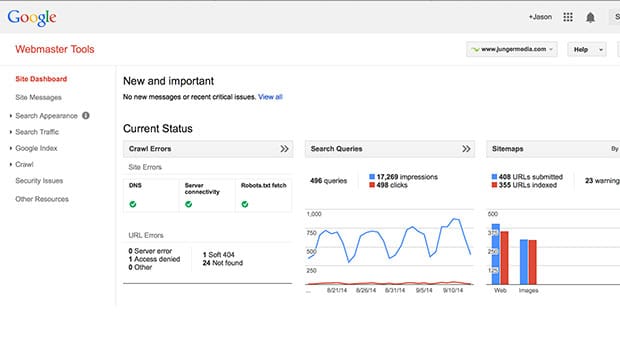Tools We Use: Google Webmaster Tools
by Jason Unger, Founder
Insights / Digital Ink /

This is the fifth in an irregular series of blog posts about the tools we use to design, develop and maintain websites and the digital products we create. We’ve previously written about the Pingdom Website Speed Test, Sprout Social, Chrome Developer Tools and Free Stock Photos.
When it comes to driving organic search traffic to your site, there’s Google. And then there’s everyone else. But while Bing and Yahoo are certainly not worth ignoring, the majority of analysis, work and conversation centers around making your site friendly to Google.
A sidebar here: I’ve talked time and time again about how relying on Google for all of your traffic is asking for trouble. You can’t neglect other forms of online marketing by investing all of your time tweaking and optimizing for Google, because if they decide to change how they work — which they often do — you’ll constantly be chasing your tail.
But, as a part of a balanced marketing plan, it’s important to ensure that you’re executing on the best practices Google suggests you implement.
The easiest way to establish a connection with Google and make sure everything on your site is copacetic is through Google Webmaster Tools. Webmaster Tools is a free service Google offers for webmasters to handle the fundamentals, including:
- submit an XML sitemap
- see how many pages have been crawled and find any crawl errors
- find others sites that link to your site
- see the top searches where your site is found in the results
- ensure you have no security errors (that Google is aware of)
Connecting a site to Google Webmaster Tools is one of the final things we do every time we launch a new site. It’s a simple process: submit the site to your account, download an HTML file, and verify you own the site by uploading the HTML file to your server.
Webmaster Tools is really the dashboard for the health of your site in the eyes of Google. If there’s a serious problem, not only will it display in your Webmaster Tools — they’ll have a message waiting for you about it. If you’re seeing significant changes in the amount of search traffic coming to your site, Webmaster Tools is the first place to go to see why.
There’s plenty of resources associated with Webmaster Tools — the Official Blog, the YouTube Channel and their Twitter account. Search Engine Watch has a great overview of the tool, with a lot of in-depth and how-to information.
Google really wants webmasters to succeed. The easier it is for them to understand the information we publish, the easier it is for everyone searching online (their users) to find what they’re looking for. It’s in their best interest to make sure that we know when there’s a problem on a site, and what we should be doing to be found.




